

Customer Experience Professionals Association. Customer Experience Matrix. Customer Experience Matters. The State of Customer Service 2012. Popular Today in Business: All Popular Articles Customer service has evolved from being a necessary cost channel, to one of the most important business differentiators in existence.
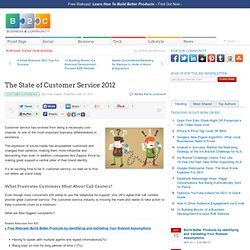
The explosion of social media has empowered customers and changed their behavior, making them more influential and demanding than ever. In addition, companies like Zappos thrive by making great support a central pillar of their brand identity. Delivering customer experience transformation. Serving Customer-Centric Business Leaders. The human factor in service design - McKinsey Quarterly - Operations - Performance. Poor customer service isn’t a headache just for consumers; it’s a problem that vexes senior managers too.
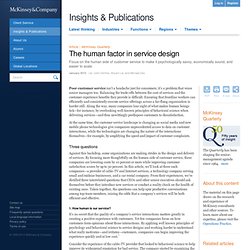
Balancing the trade-offs between the cost of services and the customer experience benefits they provide is difficult. Ensuring that frontline workers can efficiently and consistently execute service offerings across a far-flung organization is harder still. Along the way, many companies lose sight of what makes human beings tick—for instance, by overlooking well-known principles of behavioral science when delivering services—and thus unwittingly predispose customers to dissatisfaction.
At the same time, the customer service landscape is changing as social media and new mobile phone technologies give companies unprecedented access to data on customer interactions, while the technologies are changing the nature of the interactions themselves—for example, by amplifying the speed and impact of customer complaints. Three questions 1. The company completely redesigned the calls. 2. 3. Customer Experience Professionals Association. Your Call is (Not That) Important to Us.
Customer Experience Strategy. Improving the 3 C's; Communicate, collaborate, compete. Customer Relationship Management (CRM) isn’t just about installing a new piece of kit and watching it magically solve all your business problems.
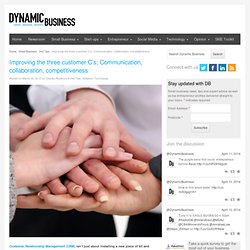
Successful deployment of CRM focuses around communication, collaboration and competitiveness. Customers today have high expectations as well as easy access to social tools to voice opinions or ask for company and product recommendations. While ensuring a positive customer interaction in person is still important to build loyalty, the experiences that customers receive online are just as critical, and even more imperative are the interactions customers have with other customers.
Organisations looking to steadily increase brand loyalty and sales are quickly realising that CRM can now offer a compelling option for companies that want a better connection with customers. At the same time, customers are looking for more than on-demand versus on-premise capabilities in their CRM solutions. Home. Call Center, Customer Service & Customer Relationship Management.
Claims of customer focus mostly talk, report finds. Companies are always saying they’re in tune with their customers, but in reality, it appears they’re not quite synchronized.
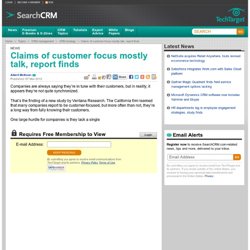
That’s the finding of a new study by Ventana Research. The California firm learned that many companies report to be customer-focused, but more often than not, they’re a long way from fully knowing their customers. One large hurdle for companies is they lack a single When you register, you'll begin receiving targeted emails from my team of award-winning editorial writers on the latest customer relationship management (CRM) and call center technology issues today. Our goal is to keep you informed on the hottest issues facing this fast-changing industry.
The Call Center's Main Purpose is to Retain Customers. The call center’s main purpose is to retain customers in order to maximize and protect the organization’s greatest asset – its customers.
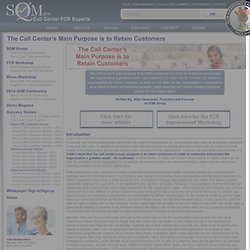
In other words, it is the call center’s responsibility to retain customers so they do not defect to the organization’s competition as a result of their call center experience, rather than the call center creating customer loyalty for the organization Written By, Mike Desmarais, President and Founder of SQM Group Introduction If you ask call center professionals what their call center’s main purpose is, you hear answers such as to service customers, to resolve their calls, to operate in an effective and efficient manner, to service and sell to customers, to create customer loyalty to the organization and to help bring in new customers to the organization.
Call Center First Call Resolution and Customer Satisfaction. From a customer perspective, this study benchmarks your call center against 450 leading North American call centers’ FCR, Csat and Customer Protection – CP SCORE™ performance, identifies repeat call reasons, provides proven best practices on reducing repeat calls and awards call centers that have demonstrated FCR, Csat and Customer Protection – CP SCORE™ excellence SQM uses the Voice of the Customer (VoC) for helping call centers deliver sustained World Class First Call Resolution (FCR) performance.
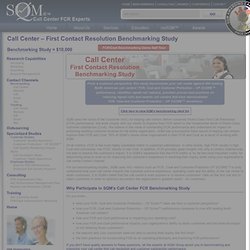
We work closely with our clients to improve their FCR which is the fundamental driver of World Class customer satisfaction (Csat). We believe in the value of outstanding FCR performance and understand its impact on protecting existing customer revenue for the entire organization. SQM has a successful track record of helping call centers improve their FCR and Csat. 70% of SQM’s clients show improvement in their FCR and Csat as a result of working with SQM. Do you know… There are two surveys: 1. How to Avoid the 9 Circles of Customer Service Hell. I'm sure you, like me, have spent too much time in customer service hell as a consumer.
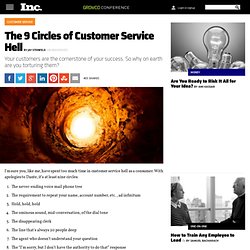
With apologies to Dante, it’s at least nine circles: The never-ending voice mail phone treeThe requirement to repeat your name, account number, etc., ad infinitumHold, hold, holdThe ominous sound, mid-conversation, of the dial toneThe disappearing clerkThe line that's always 20 people deepThe agent who doesn’t understand your questionThe “I’m sorry, but I don’t have the authority to do that” responseThe clerk who's busy texting someone who's clearly more important than you I'm sure there are more. (Leave your personal favorites in the comments!)
You don’t want this happening at your company, nor do I at mine. Staff up with the right people. Our Economy Is Mostly Services. But How Do You Design Great Service Experiences? Every time you ship a package, withdraw cash from the ATM, or call your health insurance provider, you’re experiencing a service system.
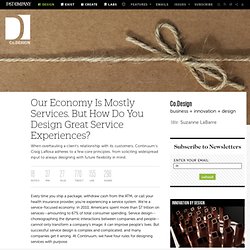
We’re a service-focused economy: In 2010, Americans spent more than $7 trillion on services--amounting to 67% of total consumer spending. Service design--choreographing the dynamic interactions between companies and people--cannot only transform a company’s image; it can improve people’s lives. But successful service design is complex and complicated, and many companies get it wrong.
At Continuum, we have four rules for designing services with purpose. 1. Many companies make the mistake of overselling their service--a strategy that backfires when customers are inevitably disappointed. 2. Executing successful service experiences requires all silos of an organization--marketing, operations, sales, finance, and so on.
Lisaford.com. The IT Service & Technical Support Community. Roy Atkinson (HDI_Analyst)